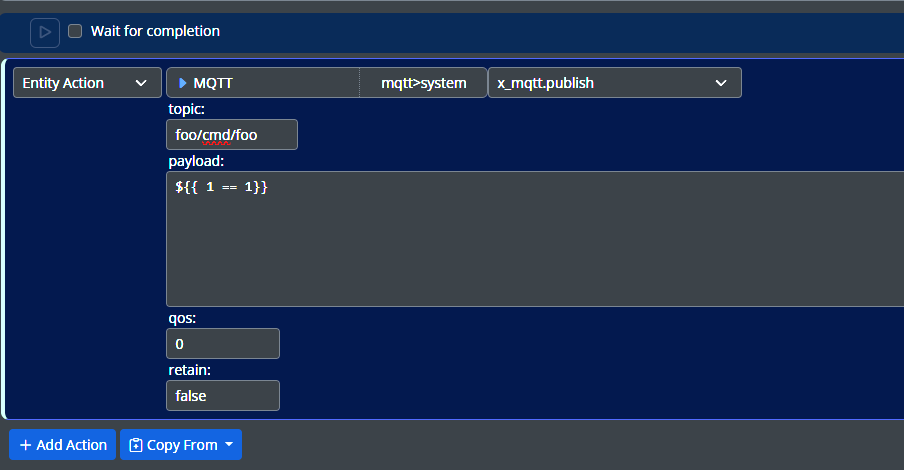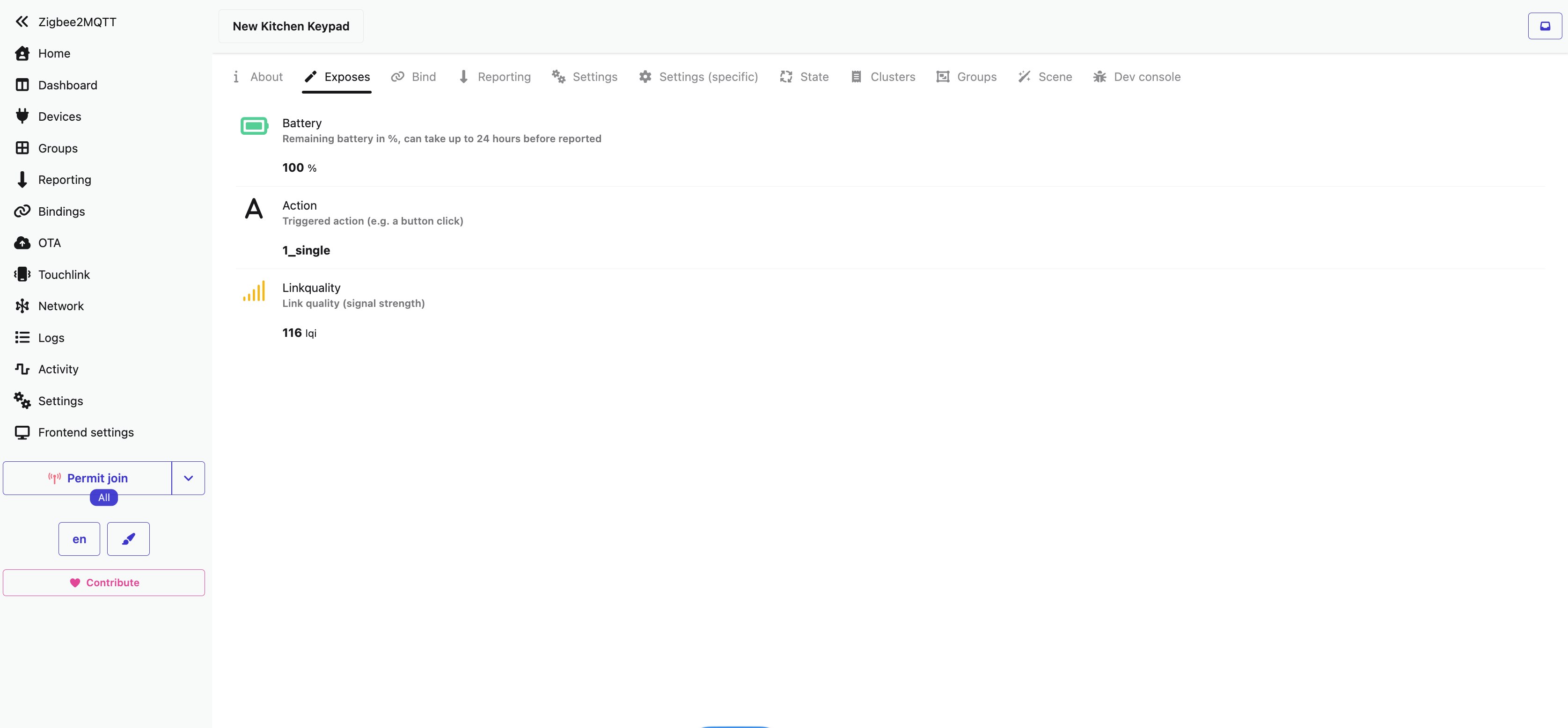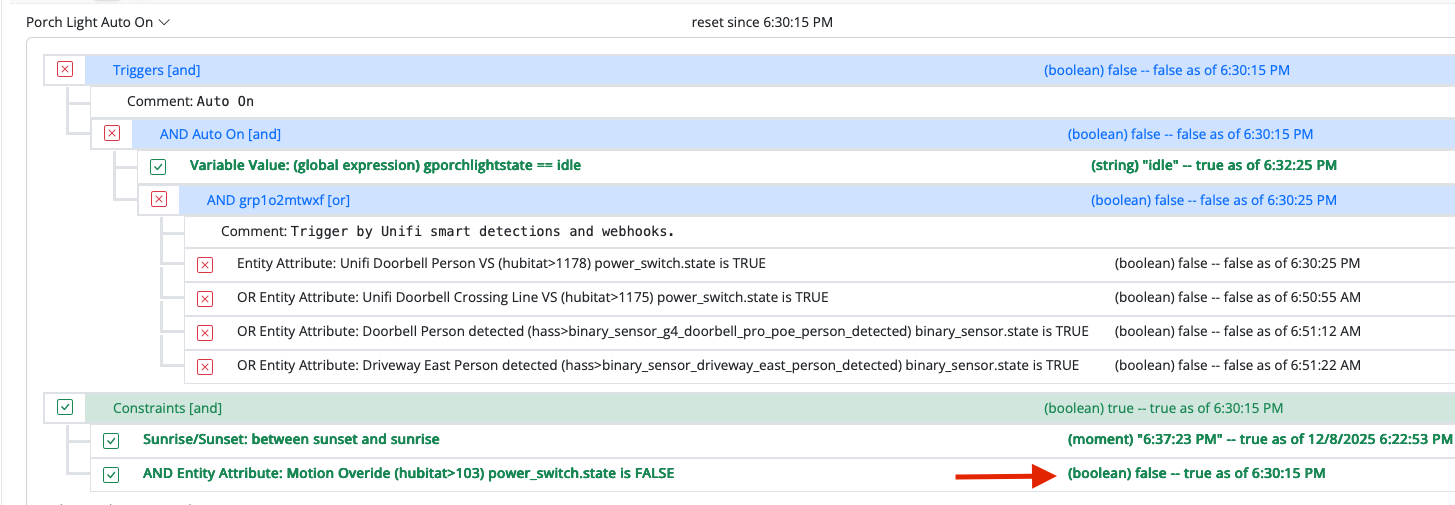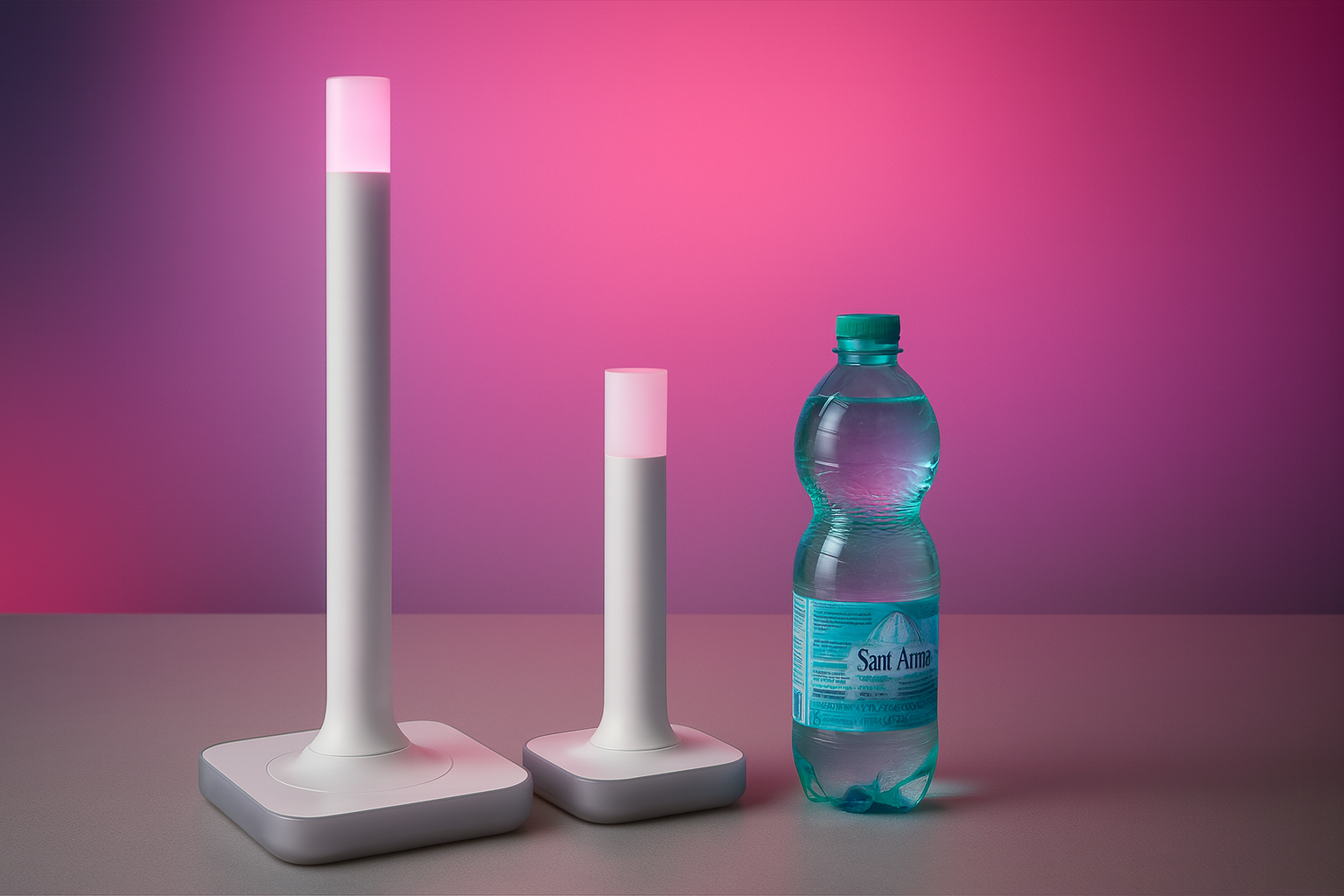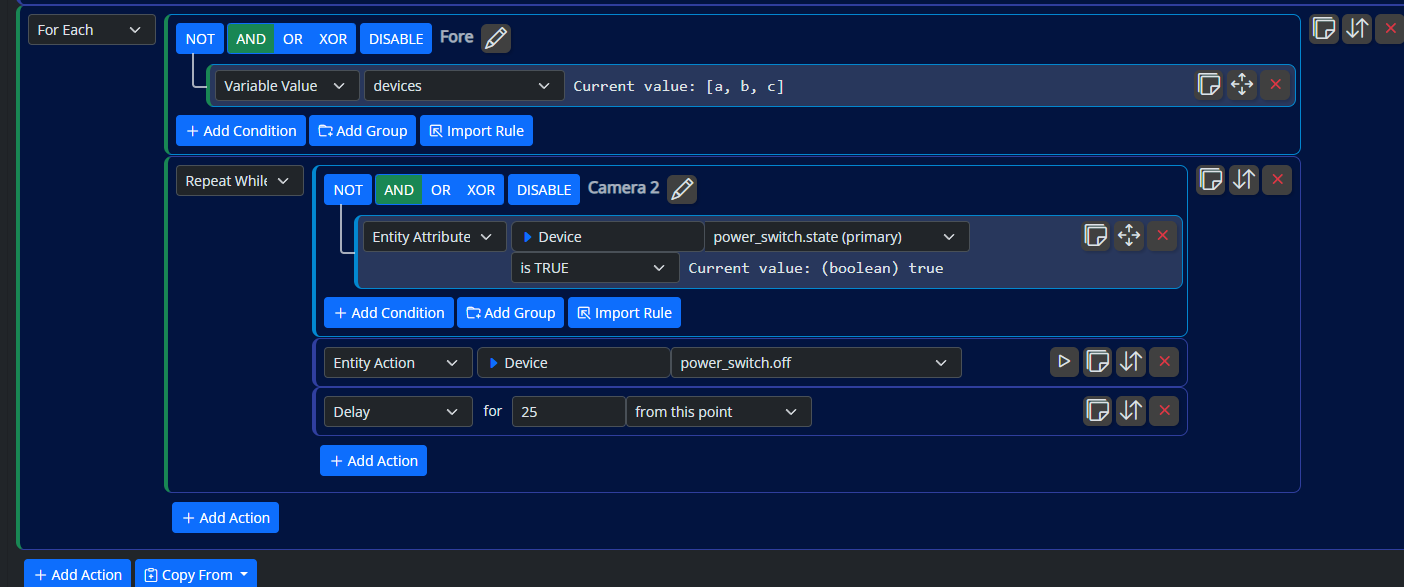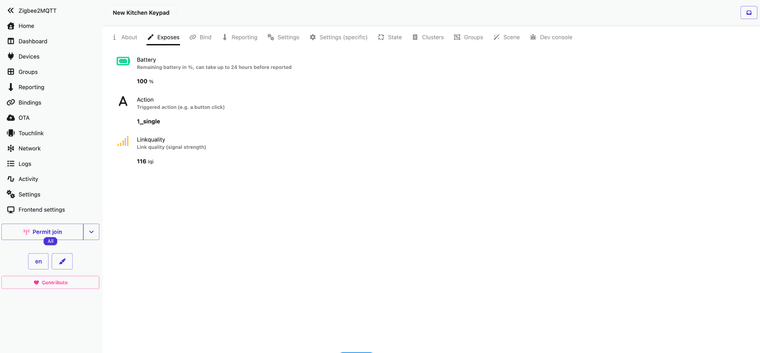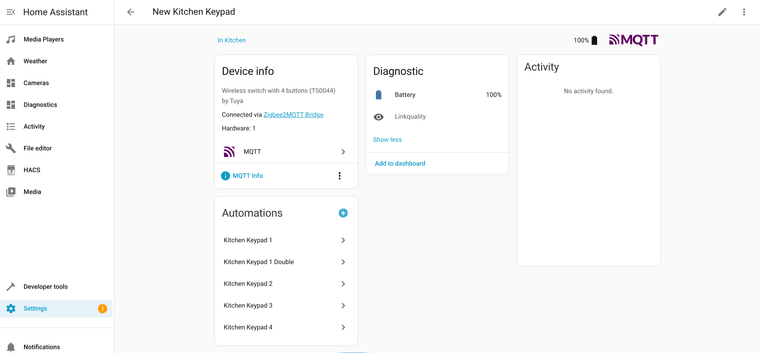CatmanV2
Posts
-
Possible feature request? -
Possible feature request?No idea how easy this would be. During my migration away from Z-wave I've been replacing the Z-wave devices with Sonoff which has broken some of my automations.
Any chance of a 'Test Reaction' function to call out which ones are broken because an entity no longer exists? Without actually running the reaction?
Or does this exist already and I'm just not aware of how to do it? Obviously I can see entities that are no longer available, but not quite what I'm looking for.
I guess it's something of an edge case so no huge issue.
TIA!
C
-
Logic Assistance: Exterior Lights on when Illuminance Below Threshold@Pabla very clever!
C
-
Genuinely impressed with Zigbee and HA / ReactorSo far just keeps getting better. I thought I'd hit a snag yesterday wit the newly installed garage light switch being slow to trigger (IRO 6 seconds) but realised I was using the wrong HASS sensor attribute (durrr) once I sorted that, it's all sorted. Typical response times are sub second.
Some oddities in where I've migrated with some hacky virtual switches which I need to track down. I'd get rid of them but trying to expose HA entities to Alexa seems a bit hit and miss...
C
-
Logic Assistance: Exterior Lights on when Illuminance Below ThresholdThat sounds very clever @Crille !. Does the light level actually increase in your case? I'd have more expected it to be constant once the lights are on? @Pabla is there actually a spike, or is the sensor reading the (one would expect) increased light level? This is assuming the sensor is within the zone of the lights....
C
-
Tuya Wifi to Tasmota flashingJust popping this in here in case it's helpful to anyone else later. I've got several Tuya Wifi sockets that I'm getting rid of / replacing. Looking at which ones, if any, can be flashed to Tasmota:
https://www.amazon.co.uk/dp/B09Y212TCK?ref=ppx_yo2ov_dt_b_fed_asin_title&th=1
Are NOT flashable
C
-
Genuinely impressed with Zigbee and HA / ReactorThe migration has started. Pulling Z-wave devices and replacing them with Zigbee. Really successful so far. Much much snappier response. No range issues as each socket I'm adding acts as a router. Gonna have a play later see if I can flash the Tuya cloud plugs I bought to Tasmota....
C
-
MQTT templates for ZIgbee scene controller, or a better way?That is very helpful, thanks. I'll enable some logging tomorrow and have a dig!
C
-
MQTT templates for ZIgbee scene controller, or a better way?Morning folks! More Zigbee fun today

Just bought me one of these to replace one of my Remotec ZRC-90s and try and speed things up

Although it's immediately visible in Zigbee2mqtt with Battery, Action and Link Quality:
And immediately pops up in HASS, HASS only exposes Battery and Link Quality:
This strikes me as a bit perverse given that HASS can (pretty obviously) react to the keypresses.
Can I use a modified (for example) Scene controller template from @therealdb to integrate direct into Reactor, or would it need to be re-written from scratch? The first may be just within my meagre talents, but I suspect not. The latter not a chance.
I can make a hack by making automations in HASS update entities in Openluup (or create virtual switches in HASS) but would like to keep my automations in one place.
Thoughts?
TIA as ever
C
-
Reset a delayThanks both! Busy day today but shall look tomorrow. Love this place
<edit> Just looks. That makes perfect sense!
C
-
Reset a delay@gwp1 Thanks. Not sure I understand, but that's on me multi-failing. I shall look probably tomorrow!
C
-
Reset a delay@toggledbits hell sorry! Not my intention at all!
Here's what I have for the one sensor that currently exists (I'm migrating) The theory remains the same, though. I want the lights to turn off three minutes after the last open event, i.e. if I open the back door (the lights come on), the delay starts. If I don't open the back door again, the lights go off after 3 minutes.
But if I open the door again after 2 minutes 30, the lights stay on for another 3 minutes.
Hopefully this will resolve my foul, but I was expecting a pointer as opposed to an answer

C
-
Reset a delayI'm sure this has been asked, and answered, but damned if I can figure it out
Use case: I have a rear garden with lights. A door from the kitchen into the garden and a door from the garage.
Currently if I open the kitchen door the lights come on (yay) and a 3 minute delay starts.
After 3 minutes, no matter what else happens, the lights go off (Boo! But also yay!)
What I would like is for the 3 minute delay until the lights go off to start from the latest door open event.
That is, if I'm going from kitchen to garage, and back again, the lights stay on until there's three minutes of no activity.
I've tried 'hacking' with a virtual switch, but can't seem to stop the delay.
Any pointers?
TIA
C
-
Genuinely impressed with Zigbee and HA / ReactorJust for the record, in case anyone is following, I'm really rather impressed.
I have installed one of these:
That's connected (physically) to the VM running on my Synology, with a 2m USB extension.
The same host also runs Openluup, Mosquito, HA Bridge.Yesterday I installed Zigbee2mqtt. That was a bit of a PITA but mostly because of ports and permissions.
Once up and running, and the correct boxes ticked, immediately visible in Home Assistant via the MQTT integration, and thence into Reactor
I've only got two devices. I bought the cheapest sensor I could find, which is a door sensor. Dead easy to add to ZIgbee2mqtt and again, immediately visible in HA.
The dongle is on the top floor of the house, and I wanted the sensor on the back door (just about as far apart as it's possible to get short of going into the garage) When I moved the sensor downstairs it dropped out pretty instantly (which wasn't a huge surprise) so quick bit of research found out that smart plugs will act as routers so...
Took me about 30 seconds to connect. Updated the name. Instantly visible in Reactor with the new name pushed over from Zigbee2mqtt.
And lo, the door sensor now has a signal of 140 and works as far as I can tell perfectly and instantly (unlike my z-wave one).
A few more of those will be purchased and used to replace the Tuya wifi cloud devices and the (continually failing) Z-wave plugs (yeah, they were TKB so....)
Commended to the house. Thanks for everyone that got me on the right lines.
C
-
Zigbee2mqtt installed! sytemctl not happy :(FFS!
User=piLooks like it's fixed
C
-
Zigbee2mqtt installed! sytemctl not happy :(Good call. Syslog:
Dec 16 12:30:09 openluup systemd[1]: Stopped zigbee2mqtt. Dec 16 12:30:09 openluup systemd[1]: Starting zigbee2mqtt... Dec 16 12:30:09 openluup systemd[2984]: zigbee2mqtt.service: Failed to determine user credentials: No such process Dec 16 12:30:09 openluup systemd[2984]: zigbee2mqtt.service: Failed at step USER spawning /usr/local/bin/node: No such process Dec 16 12:30:09 openluup systemd[1]: zigbee2mqtt.service: Main process exited, code=exited, status=217/USER Dec 16 12:30:09 openluup systemd[1]: zigbee2mqtt.service: Failed with result 'exit-code'. Dec 16 12:30:09 openluup systemd[1]: Failed to start zigbee2mqtt.Same message in all of them

zigbee2mqtt doesn't even log when started from systemctl
C
-
Any thoughts on which is betterFurther testing, I need a router decvice as by the time I move the sensor two floors down it stops responding, but I was pretty much expecting that. I can probably do something with the positioning of the dongle on its extension as well.
C
-
Any thoughts on which is betterMuch awesomeness. My test sensor is paired and showing in HA and MSR.
Ta all
C
-
Zigbee2mqtt installed! sytemctl not happy :(Hello oh great ones.
After a couple of hours messing with ports and permissions I have Zigbee2mqtt installed and running on my virtual pi
Can connect to the front end and everything

Odd one though, simply cannot get systemctl to work and the error is, well, unhelpful. The service file is this:
[Unit] Description=zigbee2mqtt After=network.target [Service] Environment=NODE_ENV=production Type=notify ExecStart=/usr/local/bin/node index.js WorkingDirectory=/opt/zigbee2mqtt StandardOutput=inherit # Or use StandardOutput=null if you don't want Zigbee2MQTT messages filling syslog, for more options see systemd.exec(5) StandardError=inherit WatchdogSec=10s Restart=always RestartSec=10s User=pi [Install] WantedBy=multi-user.targetStraight out of the docs with the change to point to my local node install (which we know works as it's the same as the very fine Reactor is using.
Running manually
pnpm startin
/opt/zigbee2mqttworks fineHowever:
catman@openluup:/etc/systemd/system$ sudo systemctl start zigbee2mqtt.service Job for zigbee2mqtt.service failed because the control process exited with error code. See "systemctl status zigbee2mqtt.service" and "journalctl -xe" for details.Which I have
catman@openluup:/etc/systemd/system$ sudo systemctl status zigbee2mqtt.service ● zigbee2mqtt.service - zigbee2mqtt Loaded: loaded (/etc/systemd/system/zigbee2mqtt.service; disabled; vendor preset: enabled) Active: activating (auto-restart) (Result: exit-code) since Tue 2025-12-16 12:32:42 GMT; 4s ago Process: 3093 ExecStart=/usr/local/bin/node index.js (code=exited, status=217/USER) Main PID: 3093 (code=exited, status=217/USER)and
-- A start job for unit zigbee2mqtt.service has begun execution. -- -- The job identifier is 17477. Dec 16 12:35:16 openluup systemd[3178]: zigbee2mqtt.service: Failed to determine user credentials: No such process Dec 16 12:35:16 openluup systemd[3178]: zigbee2mqtt.service: Failed at step USER spawning /usr/local/bin/node: No such process -- Subject: Process /usr/local/bin/node could not be executed -- Defined-By: systemd -- Support: https://www.debian.org/support -- -- The process /usr/local/bin/node could not be executed and failed. -- -- The error number returned by this process is ERRNO. Dec 16 12:35:16 openluup systemd[1]: zigbee2mqtt.service: Main process exited, code=exited, status=217/USER -- Subject: Unit process exited -- Defined-By: systemd -- Support: https://www.debian.org/support -- -- An ExecStart= process belonging to unit zigbee2mqtt.service has exited. -- -- The process' exit code is 'exited' and its exit status is 217. Dec 16 12:35:16 openluup systemd[1]: zigbee2mqtt.service: Failed with result 'exit-code'. -- Subject: Unit failed -- Defined-By: systemd -- Support: https://www.debian.org/support -- -- The unit zigbee2mqtt.service has entered the 'failed' state with result 'exit-code'. Dec 16 12:35:16 openluup systemd[1]: Failed to start zigbee2mqtt. -- Subject: A start job for unit zigbee2mqtt.service has failed -- Defined-By: systemd -- Support: https://www.debian.org/support -- -- A start job for unit zigbee2mqtt.service has finished with a failure.Which strikes me as very odd.
Any blindingly obvious things I'm missing?
TIA!
C
-
Single protocol?I wondered as well. I've got about 9 wifi devices now. Mostly wall warts, but a couple of PIRs and a mmWave presence detector arriving today. The do what they say on the box <shrug>
C

